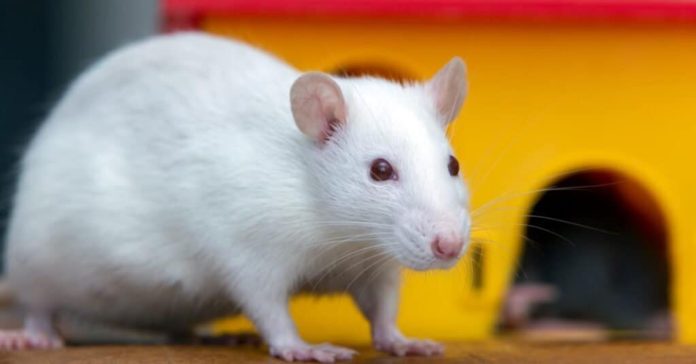Last Updated on January 15, 2024 by Fumipets
Dumbo Rats
When it comes to giving creatures names, scientists sometimes appear to have a cruel streak. After all, how else can you account for creatures like the strange-tailed tyrant, chicken turtle, and spiny lumpsucker?
The dumbo rat may be added to the list of animals with bad names. These creatures are so named because, like the elephant in the Disney film “Dumbo,” they have enormous ears. Worse still, “fancy rat” is really their genuine name rather than “dumbo rat.”
Quick Facts about Dumbo Rat
| Species Name: | Rattus norvegicus domestica |
| Family: | Muridae |
| Care Level: | Easy |
| Temperature: | 65-75°F |
| Temperament: | Mild, easygoing, cuddly, engaging |
| Color Form: | Agouti, black, lilac, fawn |
| Lifespan: | 2-3 years |
| Size: | 15-22 inches long, 1. 5 pounds |
| Diet: | Rat pellets, fruits, vegetables, lean meat, beans |
| Minimum Tank Size: | 24” x 12” x 12” |
| Tank Set-Up: | Minimal |
| Compatibility: | Gets along well with other rats |
The Dumbo Rat has been raised for companionship for such a long time that it is the most popular species of farmed rat kept as a pet.
However, their past is a bad one. Ironically, the fact that they were bred for death is one of the main reasons the species was able to thrive. They were employed as targets in blood sports in the 18th and 19th centuries. They continue to risk their lives for humans today since they are often employed in medical research.
Dumbo rats are considerably cleaner than their wild counterparts, and they are no more likely to transmit illnesses or parasites than dogs, cats, or other tiny rodents like hamsters, despite the fact that many people may find the thought of having a rat as a pet repugnant.
Due to a genetic abnormality that gives them big ears, huge skulls, tiny jaws, and wide eyes, dumbo rats are significantly cuter than most other species of rats. They look innocent because of the combination of these qualities.
They are just a prettier version of the same species of “scary-looking” rats. Since they have been domesticated for many generations, they have different habits and are more susceptible to certain illnesses, but they will still have many of the same behaviors and preferences.

How Much Do Dumbo Rats Cost?
A dumbo rat may be purchased from a breeder or pet shop for between $10 and $20, however certain colors of rats may cost a little bit more.
However, a lot of pounds and small animal shelters also accept dumbo rats, so you may be able to obtain one for free or at a low adoption cost.
Typical Behavior & Temperament
Friendly and pleasant animals, dumbo rats. They may be loving with individuals they trust and are peaceful and curious in nature. They don’t mind handling them, however it could take some time to get them used to it.
Because of their high intelligence, humans have trained numerous dumbos to do pranks. Since they are sociable animals that need continuous connection with humans or other rats, many experts advise always keeping two dumbos together.
Appearance & Varieties
Since dumbo rats have been kept as pets for a while, many breeders have sought to create distinctive markings and patterns to make them more appealing to prospective owners. Over time, the breed has also innately evolved a few traits of its own.
Agouti and black are the two main color varieties observed in dumbo rats. Agouti refers to the fact that each individual hair has three separate tones, which often combine to give them a gray or brownish appearance. However, fawn and cinnamon also contain agouti dumbos.
Beige, blue, chocolate, and pure black are examples of colors with a black basis. The dumbo’s eye color will be influenced by their coat color in part; the most frequent eye colors are black, pink, ruby, and odd-eye (two different-colored eyes).
Dumbos may have a range of markings, such as Himalayan, which is a mixed shade of white, and entirely solid markings.
There are further forms of conventional markings as well, such as:
• Hooded: A colored saddle running from the head down the spine to the tail
• Berkshire: Colored top, white belly
• Blazed: Colored head or body with white fur on the face
• Capped: White with colored fur on the head alone
• Variegated: Any sort of mismatched pattern
• Irish or English Irish: Equilateral triangle of white running down the chest or between the front legs
Additionally, there are several coat varieties. Although some kinds have silky coats or curled hair, the primary variations are in the coarseness of the fur.

How to Take Care of Dumbo Rat
Dumbo rats are very affordable and simple animals to care for. However, there is equipment that you must own if you want to maintain Dumbos; we’ll discuss the essentials below.
Habitat, Tank Conditions & Setup
Cage
Dumbo rats don’t get very large, therefore they don’t need enormous cages. You’ll need a cage that measures at least 24″ x 12″ x 12″. They love to climb and explore, so buying a tank that is the right size is crucial, but so is having a tank with several levels.
Your greatest option and much superior to tanks are wire cages, however you’ll need to place something on the bottom of the cage to prevent the rat’s feet from becoming stuck in the enclosure.
Bedding
You must line the cage with some kind of substrate in addition to placing a solid layer at the bottom of it. Two common possibilities are recycled newspaper or aspen shavings, but you may also use fabric, straw, or shredded cardboard.
Use cedar or pine shavings sparingly since they emit poisonous vapors that might make your rat ill. Additionally, you should keep your rats away from cat litter since if they inadvertently consume it, it will clump in their stomach and might be fatal. The similar problem may occur with corn cob bedding, but it can also develop mold and produce poisonous spores.
Regardless of the substrate you choose, you must regularly clean your rat’s cage to maintain their health (and to keep your room from smelling of rat droppings).
Temperature
Dumbos thrive at room temperature, so your rat will likely be at ease with whatever thermostat setting that you find tolerable. You should also give them with enclosures so they may flee if they want to in order to avoid the heat or cold in addition to maintaining the thermostat at a comfortable level.
Lighting
There’s no need to add heat lamps to your rat’s cage as long as you maintain a decent level of indoor temperature. To replicate a day and night cycle, you should strive to provide them with 12 hours of light and darkness each day.
Other Needs
Your rat will also need a playpen, a water bottle, a food dish, and a separate enclosure for when you’re cleaning their cage. You may also play with them often, which can reduce the need to purchase more amusement.
Do Dumbo Rat and Other Pets Get Along?
Due to their gregarious nature, keeping two or more dumbo rats at once is sometimes suggested. They get along with each other regardless of gender, but if you don’t want to produce rat offspring, keep males and females apart.
But if you want to prevent same-sex aggressiveness, you may also have them neutered and spayed.
Most other animals find these rats to be welcome and kind, which is a feature that often works against them. Of course, you should keep them away from your cat, and dogs may be unpredictable; some may ignore them while others may want to eat them.
You should just keep your dunce among other rats for the greatest outcomes. However, you’ll be courting problems if you choose different combinations.

What to Feed Your Dumbo Rat
Your dumbo’s diet should mostly consist of commercial rat pellets. They were created specifically to provide all the vitamins and minerals your rat needs to stay healthy. Avoid seed/grain blends, however, since rats tend to just choose their preferred components from the blend, and those components are often the least healthy for them.
Beyond that, you may feed them fresh fruits and vegetables, but watch out for overindulging in fruit that is high in sugar. Leafy green veggies are a great option since rats like them and they’re packed with antioxidants.
You may sometimes feed them grains like bread and cereal, but only around once a week. They will also consume modest quantities of meat in the form of bland chicken or scrambled eggs, both of which are quite healthy for them owing to their high protein content.
Don’t be tempted to frequently switch up the food for dumbo rats since they are creatures of habit. To prevent digestive issues, it is advised to feed them the same items regularly (assuming their regular diet has everything they need, of course).
When they are infants, you should feed them twice or three times a day; but, after they are fully grown, you may reduce it to once or twice a day. Be cautious not to overfeed them since the species has a high prevalence of obesity and diabetes.
Keeping Your Dumbo Rat Healthy
A dumbo rat may be kept healthy very easily as long as their cage is kept tidy and they are fed a nutritious food. Beyond that, they don’t need much, and bringing them in for veterinarian treatment is seldom necessary.
Unfortunately, the other side of this is that no matter what you do, your rat won’t survive very long. They only live for two to three years on average, so even if you’re meticulous about caring for your animal companion, you’ll probably only extend their lives by a few months.
As vital as meeting their bodily demands are their emotional ones. This entails providing them with a ton of love, care, and stimulation as well as other rats tremendous play and interact.
Breeding
It is often as easy as placing an unmodified male and female in the same cage and waiting if you want to create baby dumbo rats. Cajoling or other such tactics shouldn’t be necessary; you should simply let nature take its course.
But keep in mind that the dumbo gene is recessive. Two dumbos are required to produce a litter of dumbos; if a dumbo is crossed with another species of rat, just half of the offspring will be dumbos.
Finding a reputable dumbo breeder in your neighborhood shouldn’t be too difficult if you want a baby rat but don’t want to do the effort yourself (or particularly expensive).
Are Dumbo Rats Suitable for You?
The dumbo rat can be ideal for you if you’re seeking a low-maintenance pet that is as adorable and cuddly as any cat or dog. They are very sociable and capable of understanding their owners’ needs just like any other pet.
They don’t take up much space and don’t cost a lot to own either. Owning dumbos means living in a loop of being connected and having to say goodbye; of course, there is a major drawback, and that is their relatively short lifespans.
However, if you can manage the mood swings, you’ll discover a neglected pet that will make your day better every time they gaze into your eyes (and watching them twitch their little whiskers is pretty irresistible, too).


















